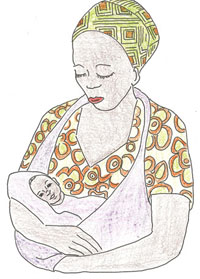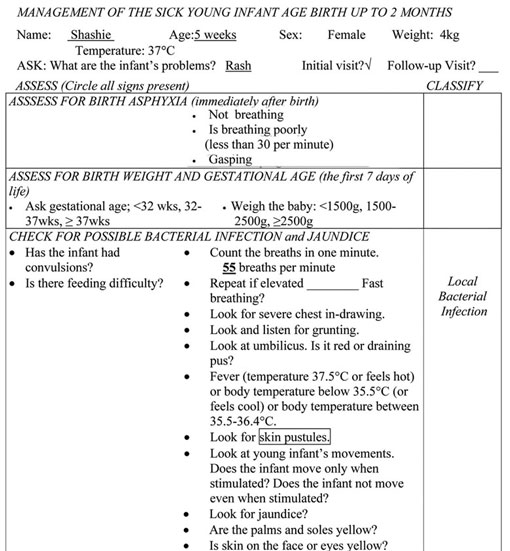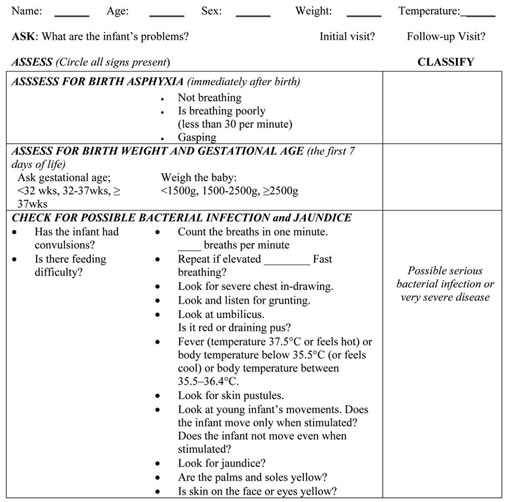3.6.5 Severe jaundice
A sick young infant with jaundice may have physiological jaundice. As you read earlier in this study session, this kind of jaundice can become worse, so you need to follow this up. You should give the mother advice on home care for the young infant, and ask her to return for a follow-up visit in two days so you can re-assess the level of jaundice present in the child.
A sick young infant with severe jaundice is at risk of suffering from bilirubin (a yellowish bile pigment that is an intermediate product of the breakdown of haemoglobin in the liver) which can cause brain damage. Therefore, you would need to refer a young infant with severe jaundice to an appropriate health facility for investigation and appropriate treatment. Before you arrange for the young infant to be referred to hospital you should ensure that he is treated to prevent low blood sugar, and that he is kept warm, both while referral is being arranged and on the way to the hospital.
Robel is a sick young infant with the classification possible serious bacterial infection or very severe disease and you decide that he needs urgent referral. What would you do before the mother takes Robel to the health centre?
The two main points to advise the mother are for her to breastfeed Robel or to give him expressed breastmilk to prevent low blood sugar, and to keep him warm to prevent low body temperature.
You are now going to do an activity which will help you to review the steps for assessing and classifying sick young infants and give you an opportunity to practise entering information about a young infant on a recording form.
Activity 3.1 Assessing, classifying and recording information
A copy of a recording form has been reproduced in Box 3.2. Look at this form now. You will notice that the information which is required on the form is similar to that set out in the chart booklet in your health post. As you can see, details such as age, weight and temperature have been entered for the young infant Shashie, whose case is set out below (Case Study 3.1). Read Shashie’s case study now, and then look at how the recording form has been completed.
Case Study 3.1 Shashie’s story
Shashie is five weeks old. Her weight is 4 kg. Her axillary temperature is 37°C. Her mother brought her to the clinic because she has a rash. The health worker assesses for signs of possible bacterial infection. Shashie’s mother says that she hasn’t seen any convulsions. Shashie’s breathing rate is 55 per minute. She has no chest in-drawing, and no grunting. Her umbilicus is normal. The health worker examines Shashie’s entire body and finds a red rash with just a few skin pustules on her buttocks. Shashie is awake, and her movements are normal. She does not have diarrhoea.
When asked if Shashie has any difficulty feeding, the mother says no. She says that Shashie breastfeeds 9‒10 times in 24 hours and drinks no other fluids. The mother empties one breast before switching to the other and says that she breastfeeds Shashie more frequently during and after illness.
Box 3.2 Recording form for Shashie
Now look at Case Study 3.2. Imagine you are the Health Extension Practitioner in this case and complete the recording form provided in Box 3.3 for Ababu.
- Label the recording form with the young infant’s name.
- From the case information, write the infant’s age, weight; temperature and problem and check the box for an ‘initial visit’.
- Record the assessment results on the form.
- Classify the infant for possible bacterial infection.
Case Study 3.2 Ababu’s story

Ababu is a three-week-old infant. His weight is 3.6 kg. His axillary temperature is 36.5ºC. He is brought to the health post because he is having difficulty breathing. You first check him for signs of possible bacterial infection. His mother says that Ababu has not had convulsions. You count 74 breaths per minute and repeat the count. The second count is 70 breaths per minute. He has mild chest in-drawing. He has no grunting, the umbilicus is normal and there are no skin pustules. Ababu is calm and awake, and his movements are normal. He does not have diarrhoea.
Box 3.3 Ababu’s record form
Comment
You should have recorded all of the information provided in the Case Study 3.2 on the recording form in Box 3.3. If you were not sure about how to do this you should talk to your Tutor at your next Study Support Meeting.
You are now going to look at the procedures you might follow if a young infant needs to be referred to hospital.
3.6.4 Low body temperature


